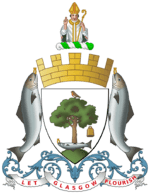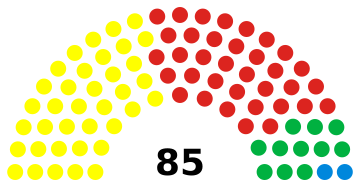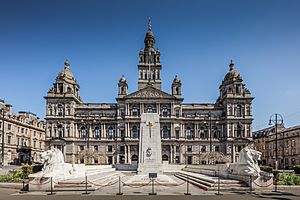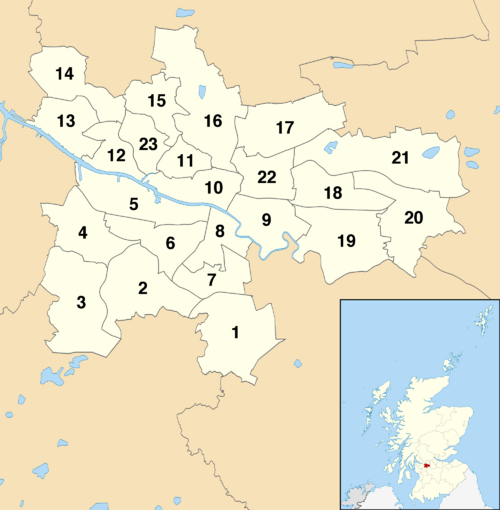Glasgow City Council facts for kids
Quick facts for kids Glasgow City CouncilComhairle Baile Ghlaschu |
|
|---|---|
| Full council election every 5 years | |

|
|

Glasgow City Council logo
|
|
| Type | |
| Type | |
| History | |
| Founded | 1 April 1996 |
| Preceded by | Glasgow Corporation (c. 1175–1975) City of Glasgow District Council (1975–1996) |
| Leadership | |
|
Annemarie O'Donnell
Since December 2014 |
|
| Structure | |
| Seats | 85 |
 |
|
|
Political groups
|
|
| Elections | |
| Single transferable vote | |
|
Last election
|
5 May 2022 |
|
Next election
|
6 May 2027 |
| Motto | |
| Let Glasgow Flourish | |
| Meeting place | |
 |
|
| City Chambers, George Square, Glasgow, G2 1DU | |
Glasgow City Council (Scottish Gaelic: Comhairle Baile Ghlaschu) is the local government that manages the city of Glasgow in Scotland. It was created in its current form in 1996.
Before 1996, Glasgow was governed in different ways. From the 1170s until 1975, it was run by a group called the Glasgow Corporation. Then, from 1975 to 1996, it was known as the City of Glasgow District Council.
Since 2017, no single political party has had full control of the council. It is currently led by the Scottish National Party (SNP). The council's main office and meeting place is the Glasgow City Chambers in George Square. This building was finished in 1889.
Contents
History of Glasgow's Local Government
Early Days: Glasgow Corporation
Glasgow got its first special permission to govern itself, called a burgh charter, between 1175 and 1178. This was given by King William the Lion. From then on, the city was run by the "Glasgow Town Council," also known as the "Glasgow Corporation." This continued until 1975.
Glasgow's boundaries, or official borders, were changed many times. This happened as the city grew bigger. New areas were added to the city's control. Some big expansions included:
- 1846: Anderston, Calton, and Gorbals
- 1891: Crosshill, Govanhill, Pollokshields, Hillhead, and Maryhill
- 1912: Govan, Partick, and Pollokshaws
- 1926: Cardonald, Crookston, Lambhill, and Yoker
- 1938: Castlemilk, Darnley, Drumchapel, and Easterhouse
Changes in 1975: City of Glasgow District Council
In 1975, local government across Scotland was changed. The old system of counties and burghs was replaced. A new two-part system was introduced. There were larger "regions" and smaller "districts."
Glasgow became a district within a larger area called the Strathclyde region. So, the local government was renamed the "City of Glasgow District Council." This new district covered a larger area than the city had before. It included places like Baillieston, Cambuslang, and Rutherglen.
Modern Era: Glasgow City Council (1996-Present)
Local government was changed again in 1996. The regions and districts created in 1975 were removed. Instead, 32 single-tier council areas were set up across Scotland. One of these was the city of Glasgow.
The council then adopted its current name: "Glasgow City Council." The area it covered in 1996 was a bit smaller than the district from 1975. For example, the Rutherglen and Cambuslang areas became part of the new South Lanarkshire council.
Political Control and Leadership
For political control before 1975 see Politics of Glasgow
The first election for the City of Glasgow District Council happened in 1974. The council officially started its work on May 16, 1975. Another election was held in 1995 before the 1996 changes.
Here's how political control has changed since 1975:
City of Glasgow District Council
| Party in control | Years | |
|---|---|---|
| Labour | 1975–1977 | |
| No overall control | 1977–1980 | |
| Labour | 1980–1996 | |
Glasgow City Council
| Party in control | Years | |
|---|---|---|
| Labour | 1996–2017 | |
| No overall control | 2017– | |
Council Leadership Roles
The council has two main leaders. The first is the Lord Provost of Glasgow. This is a ceremonial role. The Lord Provost leads council meetings and acts as a civic leader for the city. This role has existed since the 1400s. Since 1893, the Lord Provost has also been the Lord Lieutenant of the city. The current Lord Provost is Jacqueline McLaren, elected in May 2022.
The second leader is the leader of the council. This person provides the main political leadership. Since September 2017, the leader of the council also chairs the City Administration Committee.
Here are the leaders of Glasgow City Council since 1996:
| Councillor | Party | From | To | |
|---|---|---|---|---|
| Bob Gould | Labour | 1 Apr 1996 | 23 Oct 1997 | |
| Frank McAveety | Labour | 23 Oct 1997 | 6 May 1999 | |
| Charlie Gordon | Labour | 20 May 1999 | 24 May 2005 | |
| Steven Purcell | Labour | 24 May 2005 | 2 Mar 2010 | |
| Gordon Matheson | Labour | 13 May 2010 | 10 Sep 2015 | |
| Frank McAveety | Labour | 10 Sep 2015 | May 2017 | |
| Susan Aitken | SNP | 18 May 2017 | ||
Current Council Makeup
After the 2022 election, here is how many councillors each party has:
| Party | 2022 result | |
|---|---|---|
| Scottish National Party | 37 | |
| Scottish Labour | 36 | |
| Scottish Green | 10 | |
| Scottish Conservative | 2 |
Council Elections
The Glasgow City Council has 85 councillors. These councillors are elected for a five-year term. They are chosen from 23 different areas called wards.
Since 2007, elections have been held every five years. They use a system called single transferable vote. This system replaced the older "first-past-the-post" system.
The most recent full council election was on May 5, 2022. In this election, no single party won enough seats to have a majority. This was also the case in the 2017 election. The Scottish National Party remained the largest party, winning 37 seats. Labour won 36 seats, which was an increase for them. The Greens won ten seats, also improving their position. The Conservatives lost most of their councillors, ending up with only two.
The next election is planned for May 6, 2027.
Here are the election results since 1995:
| Year | Seats | SNP | Labour | Green | Conservative | Liberal Democrats | Independent / Other | Notes |
|---|---|---|---|---|---|---|---|---|
| 1995 | 83 | 1 | 77 | 0 | 3 | 1 | 1 | Labour majority |
| 1999 | 79 | 2 | 74 | 0 | 1 | 1 | 1 | New ward boundaries. Labour majority |
| 2003 | 79 | 3 | 71 | 0 | 1 | 3 | 1 | Labour majority |
| 2007 | 79 | 22 | 45 | 5 | 1 | 5 | 1 | New ward boundaries. Labour majority |
| 2012 | 79 | 27 | 44 | 5 | 1 | 1 | 1 | Labour majority |
| 2017 | 85 | 39 | 31 | 7 | 8 | 0 | 0 | New ward boundaries. SNP minority |
| 2022 | 85 | 37 | 36 | 10 | 2 | 0 | 0 | SNP minority |
Council Buildings
The Glasgow City Council holds its meetings and has its main offices at the Glasgow City Chambers in George Square.
For a long time, the Glasgow Corporation met at the Glasgow Tolbooth at Glasgow Cross. This building was rebuilt several times. Most of it was taken down in 1921, but its tall clock tower still stands.
In 1814, the corporation moved to the new Justiciary Buildings on Saltmarket. This building was used for both council meetings and as a courthouse. In 1844, the council moved again to the new Sheriff Court on Wilson Street. The Justiciary Buildings then became only a courthouse.
Finally, in 1889, the council moved into its own special building, the City Chambers in George Square, where it remains today.
City Wards
Glasgow is divided into 23 areas called "wards." These wards are how the city is split up for elections. Each ward elects a certain number of councillors. The current system of 23 wards and 85 seats was started for the 2017 council election. Before that, there were 21 wards and 79 seats.
Here are the current wards in Glasgow:
| Ward number | Ward | Seats | Population (2015) |
|---|---|---|---|
| 1 | Linn | 4 | 29,575 |
| 2 | Newlands/Auldburn | 3 | 23,144 |
| 3 | Greater Pollok | 4 | 30,729 |
| 4 | Cardonald | 4 | 29,639 |
| 5 | Govan | 4 | 26,769 |
| 6 | Pollokshields | 4 | 27,983 |
| 7 | Langside | 4 | 29,060 |
| 8 | Southside Central | 4 | 25,266 |
| 9 | Calton | 4 | 27,460 |
| 10 | Anderston/City/Yorkhill | 4 | 30,184 |
| 11 | Hillhead | 3 | 25,411 |
| 12 | Victoria Park | 3 | 20,950 |
| 13 | Garscadden/Scotstounhill | 4 | 30,565 |
| 14 | Drumchapel/Anniesland | 4 | 29,432 |
| 15 | Maryhill | 3 | 22,244 |
| 16 | Canal | 4 | 25,000 |
| 17 | Springburn/Robroyston | 4 | 27,237 |
| 18 | East Centre | 4 | 27,991 |
| 19 | Shettleston | 4 | 25,806 |
| 20 | Baillieston | 3 | 21,663 |
| 21 | North East | 3 | 20,457 |
| 22 | Dennistoun | 3 | 20,861 |
| 23 | Partick East/Kelvindale | 4 | 28,914 |
Images for kids
See also
- Demographics of Glasgow
- Politics of Scotland




